Crank Baits

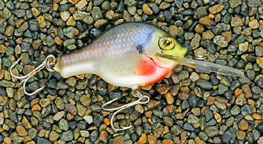
Crank baits are plugs designed primarily to imitate bait-fish and crawfish. They must be actively reeled in to activate them. Most of them rely upon a cupped bill that makes them wobble when retrieved. Those without a bill are surface plugs which struggle and splash at the surface.
The size and shape of the bill determines how deep the plug will run when retrieved. A rule is that the longer the bill, the deeper the lure will dive, and the shorter the bill, the shallower the lure will run.

The convexity of the bill causes the wobble. The more convex the bill, the more wobbling action the lure will have. The less convexity the bill has the less wobbles. It’s this side-to-side wobble that makes the crank bait appear to be alive and swimming. An exaggerated wobble


makes the crank bait appear that it is wounded and struggling with much effort to swim. Fish are attracted to this struggle because they have learned that it will be an easy catch.
Crank bait’s bills are usually made of clear plastic. This makes them difficult to see on struggling crank bait.

Crank baits come in a myriad of finishes and colors. Many of them are painted in colors and patterns that closely mimic shad, bass, bluegill, trout, and crawfish.
Typically crank bait floats at rest and the bill causes it to dive when reeled in. This makes not only for a great stop-and-go action, but helps prevent snags. The bill also orients the crank bait so its bill is much deeper than its hooks. This helps make the hooks snag-less. So you can crank it over rocks and sunken timbers.
The color to use depends upon the amount of light at the lure’s depth. This is controlled by the water’s clarity and by the amount of sunlight.
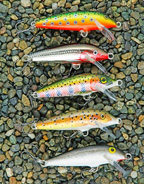

Recall the colors of the rainbow ROYGBIV (red, orange, yellow, green, blue, indigo and violet). The first three, ROY (or red, orange, and yellow), require a brightly lit condition to be visible. G (or green) is visible in average lighting. BIV (or blue, indigo, and violet) retain their coloration even in poor lighting. Generally, select your lure coloration using this as a general rule. There are exceptions to all rules, so don’t be afraid to experiment.
True silver and white seem to be effective in all lighting conditions. Chartreuse works well in dark lighting. Glow-in-the-dark paints are also easily seen in dark conditions.
Line diameter and density affect the lure’s driving depth. The rule here is that the thinner lines dive the lure deeper than the thicker lines. Fluorocarbon is more dense than monofilaments and super liens and therefore causes the lure to run deeper.
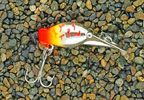
Finally, the last major factor is line length. The longer the line, the deeper the lure will run, and the shorter the line, the shallower it will run. An exception here is that at a certain depth the crank bait will suspend and not run any deeper no matter what you may do with line length and diameter.
An assortment of crank baits with varying bill lengths can help you fish at different desired depths.
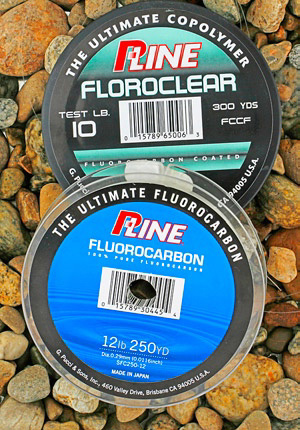
Again, the billless baits are designed to disturb the surface. They pop and splash when jerked, and they cause a V wake when steadily retrieved.
Crank baits can be used to effectively fish the surface and desired depths to about 25 feet. They can also crawl over bottom obstructions and they have that struggling action of an impaired bait fish.
Crank baits are searching lures designed to cover lots of water. They seek the reaction bite. I like to be in contact with the bottom at first. Next, on the stop, the lure seductively wiggles upwards. It’s like a minnow that is about to turn belly up and float. On the go, the crank bait struggles to reach the bottom. I sometimes opt for crank bait that dives deeper than the depth I’m fishing. This makes it a snap to reach the bottom. But with a grassy bottom I prefer more shallow-running bait. This prevents weedy hook ups.
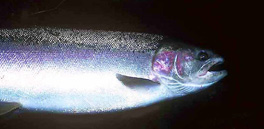
Unfortunately, you must fish the structure to catch the warm water species like bass and pike. Fishing crank bait over open water is like fishing on your back lawn.
Tackle considerations are simple. I want a fast, speedy, retrieve reel like a 5.7 to 1 ratio. That is, one handle turn rotates the spool 5.7 revolutions. The rod
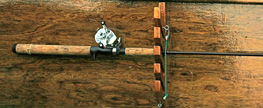
is a 6 ½ to 7 footer with medium action. The line is an eight or ten pound test.
A plug’s action needs to be tested. You want a plug that runs true. If it flops to one side it will likely be unproductive. It’s easy to tune a plug by carefully bending its eye. Once properly centered, the crank bait will run true. You can tune it up by bending the wire eyelet either to the left or to the right until its action is correct. I want my plugs to run evenly with a side-to-side wobble. I don’t want it to turn more to one side or to turn over on its side.
Many crank baits have sound in the form of a rattle. I’ve found these to work when lighting conditions are poor. They also are effective when the fish are on the bite. But when the fish are moody and the water is clear, the rattle seems to make the bite

poorer.
A good quality snap is my favorite way to attach a crank bait. The Duncan loop or Rapala knot is another effective connection. You want the crank bait to have freedom when it comes to movement. A stiff, heavy line tightly tied to the eyelet cuts down on the plug’s action.

In general, the thin crank baits such as the traditional Rapala run with a wiggle while the thick-bodied
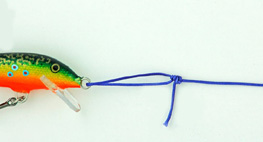
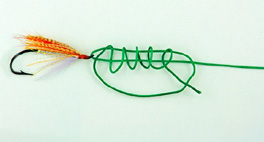

baits run with a wobble.
The line tie location of the plug is an indicator of its depth. If you tie it close to the bill’s end, the bait will run shallower. If the tie is far from the bill’s end, it will run deeper. A bill angled downward will cause the crank bait to run shallow. A bill that is straight will dive deeper. The closer the tie is to the face of the lure, the tighter the wiggle.

An easy modification is to sharpen the plastic bill by filing it so the bill is sharp. A file works well. The sharpened bill cuts through the water more easily. It makes the bait run deeper and it enhances its action.
The fishing method when using crank bait is to throw it into cover and crank it down so it bumps off of the bottom. When it kicks into a rock, pause and let it float up. That’s when a bass is most likely to strike.

Cast crank baits as far as you can when searching for fish. Crank it fast to get it down and then vary the retrieve. You can slowly retrieve it over the bottom, or you can sweep the rod sideways and retrieve in the slack. Another option is to reel moderately fast in


a stop-and-go series. When you feel it hit a rock, stop the lure so it floats upwards.
Crank baits are designed to be surprisingly snag-less. Their nose-down inclination shields the treble hooks from the snags.
Perhaps the most effective retrieve is to cast past your target and quickly crank it down so that it is at the right depth when it’s inside your target. Then slow up the retrieve in an erratic stop-and-go action. This slowed-up, erratic retrieve draws the most strikes. Since you must overcast your target, it means that your position in the approach must be closer than normal. So quietly place the boat closer or stealthily sneak up into place. A proper approach is essential.

The tight wigglers can be fished at high speeds while the wobblers are best fished on slow. There is no need to use a swivel because crank baits do not revolve when retrieved.
Crank baits are expensive, so it is intimidating when you’re snagged up. Purchase a de-snagger and use it. There are several models that can be run down the line and can pull out the snagged crank bait with a heavy cord. One model comes with a telescoping pole which is effective, but you need to be in a boat to use it effectively. When bank fishing, try not to pull out the snagged crank bait in the same direction that it got

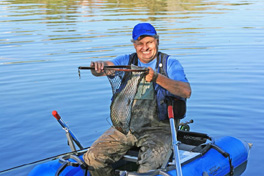
snagged-- move to a radically new location and then pull. Hopefully it will come free. One disadvantage is that I lose plenty of crank baits when I’m using eight or ten pound mono line. A thirty pound Fire Line has the same diameter, but allows you much more pulling power. But now you must also use a heavier leader to use this stronger line. A twenty pound fluorocarbon knotted to a snap gives you a stealthy presentation. So when I’m committed to bank fishing, I use the super line and heavy fluorocarbon leader.
In conclusion, crank baits can be fished at a wide variety of depths. A large variety of fish species, from bass to steelhead and salmon, can be taken on plugs. Match the size and the shape of the crank bait to the bait fish in your waters.
Perhaps fall is my favorite time to fish crank baits. The bait fish are fully grown and the fish feed heavily upon them. When fishing near schools of suspended bait fish, select your lure so it will work under the school.



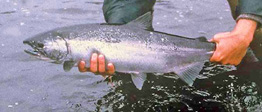

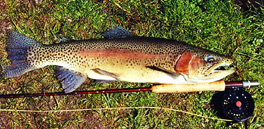

© 2025 The Gale Group, Inc. All rights reserved.
© 2025 Perigee Learning LLC. All rights reserved.
LoveTheOutdoors.com is owned and operated by Advameg, Inc. © 2025 Advameg, Inc.
Camping Adventures • Dutch Oven Cooking • Sports Knots
Fly Tying • Freshwater Fishing • Fly Fishing

